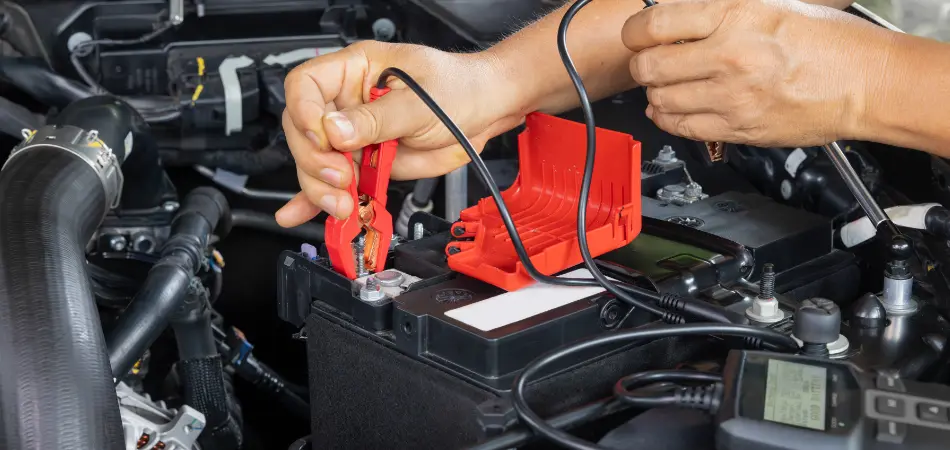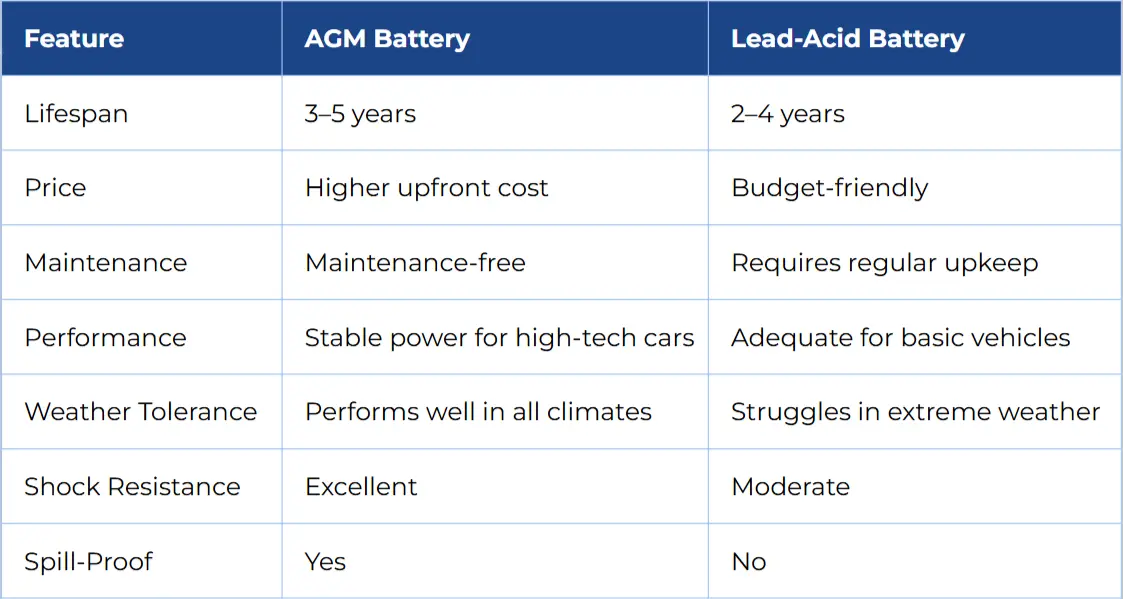AGM Vs. Lead-Acid Battery: Which Is Right for Your Car?

Shopping for a new car battery — how complicated can it be?
Maybe more than you realize. You should consider:
- Battery Type: AGM (absorbent glass mat) or traditional lead-acid?
- Cold Cranking Amps (CCA): Does the battery have enough juice to start your car reliably in cold weather?
- Reserve Capacity (RC): Does the battery have reserve capacity to power your vehicle’s electrical systems when the alternator can’t?
- Compatibility: Does the battery’s size, voltage, and terminal placement match the requirements of your car’s model and year?
In this blog, we’ll discuss the first bullet point: AGM versus lead-acid, two of the most common battery types.
What Is an AGM Battery?
AGM stands for Absorbent Glass Mat. It’s a type of lead-acid battery designed for better performance. Unlike traditional lead-acid batteries, AGMs use a fiberglass mat to hold the electrolyte (acid), which makes them spill-proof.
Key Features of AGM Batteries
- Higher Performance: AGM batteries can handle more electrical demands, making them ideal for modern cars with advanced features like start/stop technology.
- Maintenance-Free: They’re sealed and don’t need topping off with distilled water.
- Shock Resistance: AGM batteries resist vibrations better, making them the best choice for vehicles driven on rough terrain.
Advantages of AGM Batteries
- Longer Lifespan: AGM batteries usually last 3–5 years, often outpacing traditional lead-acid options.
- Faster Charging: They recharge faster than their wet-cell lead-acid counterparts.
- Spill-Proof Design: The sealed casing prevents leaks, making AGMs safer.
- Better Performance in Extreme Conditions: AGMs handle hot and cold temperatures better than lead-acid batteries.
- Ideal for High-Tech Cars: Cars loaded with infotainment systems, GPS, and other electronics benefit from AGMs’ stable power.
Disadvantages of AGM Batteries
- Higher Cost: AGMs are generally more expensive upfront than lead-acid batteries.
- Overcharging Risks: AGM batteries are more vulnerable to damage from overcharging.
- Lack of Compatibility: Not all cars are designed to handle AGM batteries.
What Is a Lead Acid Battery?
Lead-acid or flooded batteries are among the oldest car battery technologies. They feature plates submerged in a liquid electrolyte (a mix of sulfuric acid and water).
Key Features of Lead Acid Batteries
- Proven Technology: Used for decades, they’re well understood and widely available.
- Affordable: Lead-acid batteries are more budget-friendly.
Advantages of Lead Acid Batteries
- Lower Initial Cost: These batteries are significantly cheaper than AGM models.
- Easier to Manufacture and Source: Lead-acid batteries are available almost everywhere.
- Reliable for Basic Needs: They work well for vehicles with standard electrical demands.
Disadvantages of Lead Acid Batteries
- Shorter Lifespan: They typically last 2–4 years compared to 3–5 years for AGMs.
- Prone to Leaks: Since they aren’t sealed, they can spill acid if tipped or damaged.
- More Maintenance Needed: Require regular checks and refills of the liquid electrolyte.
- Performance Issues in Extreme Weather: Lead-acid batteries can struggle in very cold or hot conditions.
Comparing AGM & Lead Acid Batteries

Which Is Right for Your Car?
Choose AGM if
- You have a modern car with advanced electrical systems.
- You frequently drive on rough roads or in extreme weather.
- You prefer a low-maintenance, longer-lasting option.
Choose Lead Acid if
- You’re looking for a budget-friendly battery.
- You have a vehicle with standard electrical demands.
- You don’t mind performing routine maintenance.
If unsure, check your vehicle’s owner’s manual or consult a professional mechanic. Some cars are designed for one specific type of battery and may not function properly with the other.
FAQs: AGM Vs. Lead Acid Batteries
Q: Can I replace a lead-acid battery with an AGM battery?
Yes, but check if your car supports AGM batteries. Some older or basic vehicles may not be compatible.
Q: Do AGM batteries require a special charger?
Yes. AGM batteries need a compatible charger to prevent overcharging and damage.
Q: Are AGM batteries worth the higher cost?
Due to their enhanced performance and longer lifespan, AGM batteries are often worth the investment for vehicles with high electrical demands or those driven in extreme conditions.
Q: How do I know if my car needs an AGM or lead-acid battery?
Check your vehicle’s owner’s manual or consult with a mechanic. Many modern cars specify the type of battery required.
Q: How often should I check a lead-acid battery’s fluid levels?
It’s a good idea to check every few months and top off with distilled water if needed.
Q: Can AGM batteries be installed in any position?
Yes, due to their sealed, spill-proof design, AGM batteries can be installed in almost any position. However, they shouldn’t be installed upside down.
Q: Why do lead-acid batteries need regular maintenance?
Lead-acid batteries aren’t sealed, so water in the electrolyte can evaporate. Regular maintenance, such as checking fluid levels and adding distilled water when needed, ensures proper operation and prevents damage.
Q: How can I extend the lifespan of my car battery?
Avoid frequent short trips, keep terminals clean and corrosion-free, and ensure your charging system functions correctly. For AGM batteries, use a compatible charger if charging is needed. Proper storage in moderate temperatures also prolongs performance.
More Articles

0 Comments